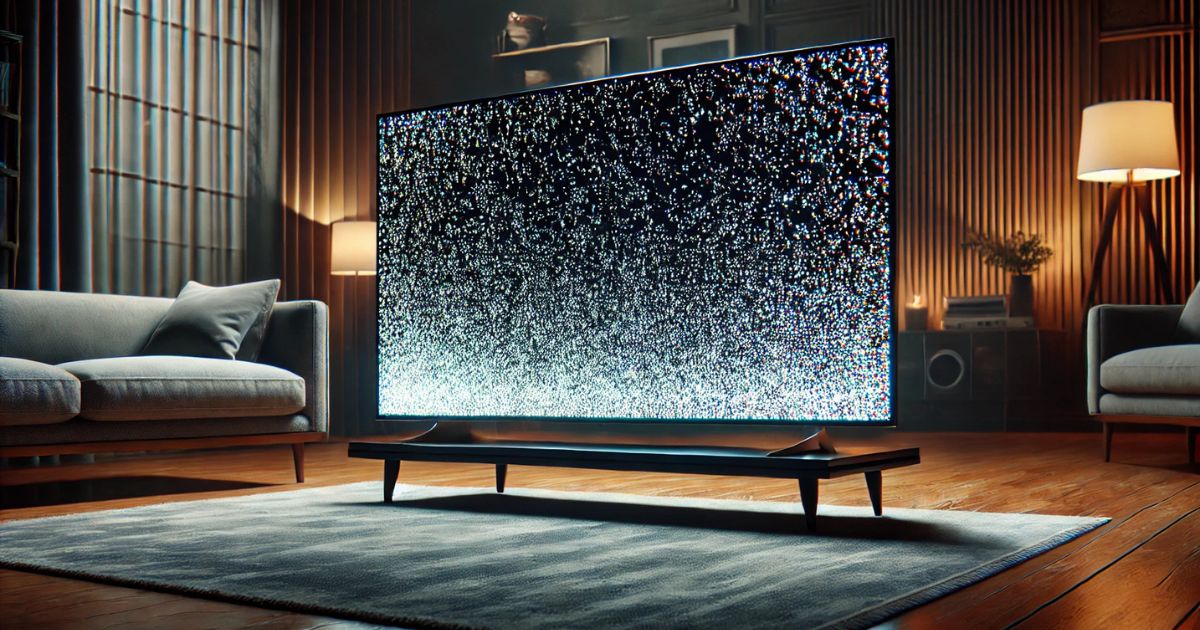Introduction
As a Hisense TV owner, I’ve encountered white spots on my screen before, and it can be pretty frustrating when they suddenly appear. The reason behind these white spots is often linked to faulty screen components. These could be reflectors, a damaged processor, or even dead pixels. When these parts fail, it leads to those annoying white spots that disrupt your viewing experience. In some cases, turning off the local dimming feature could also be a cause. It’s a little-known issue, but one I’ve personally dealt with when my TV’s brightness setting was not calibrated right.
Understanding the Causes Behind White Spots on Your TV Screen

If you’re facing white spots on your Hisense TV, it might feel like your screen is suddenly damaged, but don’t worry – there are a few common causes that can be easily fixed. One of the main reasons for these white spots is fallen reflectors. Your TV uses LED lights with reflectors that spread light evenly across the screen. If these reflectors come loose, usually due to overheating or poor screen quality, they can result in those bright white spots. It’s like the reflectors just aren’t doing their job properly, which affects your viewing experience.
Another possible cause is a damaged processor. Overheating is a usual suspect here, and it could be because the processor has been running too hot due to prolonged usage without a break. If the processor gets too hot, it could malfunction, leading to those annoying white spots appearing on your screen. Even an electrical surge could potentially cause the processor to malfunction. If you notice white spots and your TV has been running for extended periods without cooling, it’s time to give your processor some attention.
Local Dimming and Pixel Issues: Other Hidden Culprits
Dead pixels are another culprit that can show up as small white spots on your Hisense TV. These pixels might freeze or become damaged, and over time they become noticeable as tiny white spots. Since pixels make up the image on your TV screen, when they stop working correctly, it can disrupt the visual quality. Additionally, local dimming is a feature designed to enhance the picture quality by adjusting the backlight based on what’s being displayed. However, if the local dimming feature is turned off, it could result in uneven lighting and create those bothersome white spots.
You might not realize how important local dimming is until you start seeing these white spots. When it’s disabled, the lighting can become inconsistent, leading to areas of the screen that are brighter than others, making the spots more visible. Always check if local dimming is enabled to prevent such issues from arising.
Troubleshooting and Fixing the Issue: Steps You Can Take
When it comes to fixing Hisense TV white spots, it’s important to first identify the root cause. If it’s due to a fallen reflector, you might need to carefully open your TV and reposition the reflectors. If you’re not confident doing this yourself, seeking help from a professional can prevent further damage. For damaged processors, it’s crucial to ensure your TV isn’t overheating. Allowing the TV to rest and cool down between usage is essential. If the processor is still malfunctioning, contacting Hisense customer support or a qualified technician could be your best option. Lastly, if dead pixels are the problem, some TV models offer software fixes that can help “wake up” frozen pixels, but if they’re severely damaged, a screen replacement might be necessary.
It’s worth noting that some issues with white spots can also be solved by resetting the TV to factory settings. However, before performing a factory reset, ensure that you back up all important information since this process erases everything on your TV.
Troubleshooting Power and Connection Issues

If your Hisense TV has white spots, the first step is to check the power cord and make sure it is securely plugged into both the TV and the wall outlet. A faulty connection can cause display issues, so test the outlet by plugging another device to see if it works. If the outlet is functional, inspect the cord for any damage or fraying. A damaged cord might disrupt power flow, leading to inconsistent screen performance.
Sometimes, the issue isn’t just with the power; a faulty HDMI cable could also be the culprit. If you’re using an external device, try swapping the HDMI cable to rule out connection problems. A defective HDMI cable can create display distortions, affecting your TV’s picture quality. If none of these steps work, you should perform a power cycle—unplug the TV, wait for 30 seconds, and then plug it back in. This helps reset the internal system, often fixing minor glitches.
Fixing Picture and Audio Problems
A Hisense TV with poor picture quality might need an adjustment in its picture settings. Navigate to the TV settings and experiment with brightness, contrast, and sharpness until the picture improves. If you’re using an antenna, make sure it is positioned correctly to get the best signal strength and optimal reception. Additionally, an outdated firmware can impact performance, so check for firmware updates and install them to enhance TV functionality.
If you’re using external speakers, try switching the audio output source from the TV settings to see if that resolves the issue. Sometimes, a firmware update can fix audio-related bugs, so always keep your TV software updated.
Dealing with Remote and App Issues
A non-working remote control can be frustrating, but the fix is usually simple. First, replace the batteries with fresh ones.
If your TV apps are loading slowly or not working, first check your internet connection to ensure it’s strong and stable. Next, try clearing the app cache in the TV’s settings to remove any temporary data that might be causing performance issues. If the problem persists, uninstall and reinstall the app. As a last resort, a factory reset can restore the TV to its original state, but remember that this will erase all settings and data.
How to Fix a Damaged Processor on Your Hisense TV
A damaged processor can cause white spots on your Hisense TV, making it difficult to enjoy your favorite shows. I once faced this issue, and at first, I thought I had to replace the entire TV. However, I discovered that adjusting the TV settings could reduce the white dots. Start by lowering the backlight to the lowest level and reducing the brightness. Turning off the auto-adjustment feature and switching all settings to manual can also help. If these fixes don’t work, you might need to replace the processor, which can be tricky and may require a professional.
Dealing with Dead Pixels
Dead pixels can make the screen look uneven, and while fixing them is difficult, I found that sometimes a simple trick can work. Turn off your TV and take a clean microfiber cloth to gently press the white spots. This method sometimes revives frozen pixels. If the pixel remains unresponsive, the only solution might be to replace the TV.
Enable Local Dimming for a Better Display
One feature that many Hisense TV owners overlook is local dimming. This setting helps balance the lighting on the screen, reducing white spots caused by uneven lighting. I remember when I first discovered this feature—it made a huge difference in how the picture looked. Make sure local dimming is turned on in your TV settings for the best results.
Cost of Fixing White Spots
The cost to fix white spots on a Hisense TV depends on the severity of the problem. A simple adjustment to the settings is free, but if you need to replace the processor or fix dead pixels, the price can range from $80 to $170. If the damage is severe, replacing the TV might be more cost-effective. Always check if your TV is under warranty before paying for repairs.
Preventing Future White Spots
To keep your Hisense TV in good condition, avoid setting the brightness too high and ensure that the backlight isn’t overused. If your TV has a local dimming option, keep it enabled. Regularly clean the screen with a microfiber cloth to prevent dust buildup, which can sometimes cause pixel issues. Taking care of your TV can help prevent white spots from appearing again.
Hisense TVs Lifespan and What to Expect
If you’re dealing with white spots on your Hisense TV, it might help to understand how long these TVs typically last. Hisense TVs are generally built to last up to ten years with proper care. But with daily use, you can expect a lifespan of about seven to nine years. Ensuring your TV gets regular breaks by turning it off for four to six hours a day can help it last even longer. This also minimizes the chance of developing problems like white spots.
Difference Between White Spots and Pressure Marks
Many Hisense TV owners mistake white spots for pressure marks, but they are not the same thing. Pressure marks appear when the screen is physically pressed, often causing black or white spots that resemble bruises or shadows. On the other hand, white spots on a TV are typically caused by issues with internal components like dead pixels or fallen reflectors. Identifying whether the spots are pressure marks or white spots is important to figure out the right solution.
How to Fix White Spots on Your Hisense TV
To fix white spots quickly, one approach is to check the power cycle of your TV. A simple fix can be to unplug your TV, wait for about 60 seconds, and then plug it back in. This can reset the TV, resolving several basic issues, including white spots. It’s a simple yet effective fix that can save you a lot of time and money. If the white spots persist after this step, it might be worth checking your TV’s software settings or considering a factory reset.
Remote Control and Connection Issues
Sometimes, your Hisense TV may appear unresponsive to your remote control, and you may think it’s a problem with the TV itself. In most cases, though, the issue lies with the remote. Try changing the batteries, and if that doesn’t work, perform a power cycle on the remote by holding the power button for about 30 seconds. Doing this can help bring the TV back to life and get rid of potential standby mode glitches that could be causing issues like white spots.
HDMI and Input Source Challenges
If you’re seeing white spots, check your input source. Make sure the correct input is selected, especially if your device is connected to HDMI 2, but the TV is set to HDMI 1. This can sometimes cause the TV to appear off or display strange problems, including white spots. Cycle through the input sources to make sure everything is connected properly. If this doesn’t fix the issue, you could try replacing cables or ports, as defective HDMI cables or ports can also contribute to display issues.
Screen and Display Problems: Black Screen and Backlight
Another common problem is the black screen issue. To check, shine a flashlight on the screen. If you can see dull images, then the backlight might be the issue. In this case, you’ll likely need to contact Hisense support for a more advanced solution. If the TV is still working but the HDMI fails to transmit data correctly, reconnecting the HDMI cable or switching to a different port may resolve the issue.
Dealing with Software and Hardware Issues
In some situations, even after trying the basic fixes, you may need to consider a factory reset. This will erase your personal data and reset the TV to its original settings, which can help resolve deeper software issues. If all else fails, the problem might lie in the hardware itself, requiring you to contact Hisense support for further assistance or possibly even a replacement. It’s important to consider all of these solutions before jumping to conclusions.
Conclusion
Dealing with white spots on your Hisense TV can be frustrating, but with a little troubleshooting, it is often possible to fix them without professional help. Whether the issue is related to fallen reflectors, damaged processors, dead pixels, or even an incorrect input source, there are various steps you can take to resolve the problem. Checking basic things like your power cycle, local dimming settings, and HDMI connections can often yield quick fixes. If these don’t work, more advanced methods like a factory reset or reaching out to Hisense support might be necessary. By understanding the root causes of these white spots and using the right techniques, you can get back to enjoying a clear, beautiful picture in no time.
FAQs
Q1. What causes white spots on my Hisense TV screen?
White spots are usually caused by fallen reflectors, a damaged processor, dead pixels, or improper settings like turning off local dimming.
Q2. How can I fix white spots on my Hisense TV?
You can try performing a power cycle, adjusting local dimming, checking your HDMI cables, or performing a factory reset to fix the issue.
Q3. Should I contact Hisense support for white spots?
If the basic fixes don’t work, it’s a good idea to contact Hisense support to resolve hardware issues or get help with advanced troubleshooting.
Q4. Can a factory reset help with white spots?
Yes, in some cases, a factory reset can help fix software-related issues that may be causing the white spots. However, be sure to back up important data first, as this will erase everything.
Q5. Can dead pixels cause white spots on the screen?
Yes, dead pixels can appear as white spots on the screen. If they are stuck or damaged, they may need repair or replacement.
